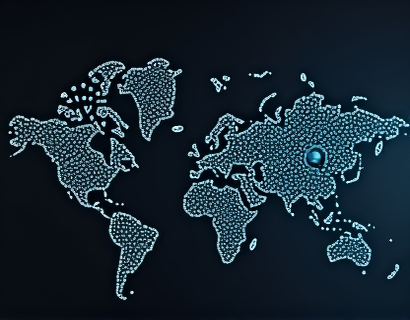Decentralized AI-Driven Ecosystem: Revolutionizing Digital Transformation with Crypto-Powered Innovations
The digital age has ushered in a new era of technological advancements, where artificial intelligence (AI) and cryptocurrency are converging to create a decentralized ecosystem that is transforming the way we interact with digital applications and services. This ecosystem, powered by the synergy of AI and blockchain technology, is redefining user experiences, enhancing security, and fostering innovation across various industries. This article delves into the intricate details of this convergence, exploring how it is revolutionizing digital transformation and paving the way for a more decentralized and user-centric future.
Understanding the Decentralized Ecosystem
A decentralized ecosystem is one where control and decision-making are distributed among multiple nodes or participants, rather than being centralized in a single entity. This approach leverages blockchain technology, which provides a transparent, secure, and tamper-proof ledger for transactions and data storage. When combined with AI, the ecosystem gains the ability to process vast amounts of data, learn from patterns, and make intelligent decisions autonomously.
The integration of AI in a decentralized framework allows for the creation of smart contracts that can execute, manage, and enforce agreements without intermediaries. These smart contracts are self-operating and can automate complex processes, reducing costs and increasing efficiency. The decentralized nature ensures that no single point of failure exists, making the system robust and resilient to attacks or failures.
AI in Decentralized Applications
AI plays a crucial role in enhancing the functionality and user experience of decentralized applications (dApps). Machine learning algorithms can analyze user behavior, predict trends, and personalize content, making dApps more intuitive and user-friendly. For instance, in decentralized finance (DeFi), AI can optimize trading strategies, assess risk, and provide real-time market insights, enabling users to make informed decisions.
Moreover, AI-driven chatbots and virtual assistants can provide 24/7 customer support within dApps, handling queries and transactions seamlessly. These AI-powered tools can understand natural language, process complex requests, and interact with users in a human-like manner, significantly improving the user experience.
Enhanced Security and Privacy
One of the most significant advantages of a decentralized AI-driven ecosystem is the enhanced security and privacy it offers. Blockchain's inherent properties, such as immutability and transparency, ensure that data is secure and tamper-proof. AI can further bolster security by detecting and mitigating potential threats in real-time, identifying anomalies, and preventing fraudulent activities.
Privacy is another critical aspect where this ecosystem excels. Cryptographic techniques and zero-knowledge proofs allow users to maintain control over their data while still enabling secure and verifiable transactions. AI can help in anonymizing data and ensuring that user information is protected, thus building trust and confidence in the ecosystem.
Use Cases Across Industries
The applications of a decentralized AI-driven ecosystem are vast and varied, spanning multiple industries. In healthcare, AI can analyze medical data stored on a blockchain to provide accurate diagnoses and personalized treatment plans. Smart contracts can manage patient consent and data sharing, ensuring compliance with regulations and enhancing patient privacy.
In the supply chain industry, blockchain can track the movement of goods in real-time, while AI can optimize logistics and predict demand. This combination reduces fraud, increases transparency, and ensures efficient resource allocation. For example, farmers can receive real-time market prices for their produce, and consumers can trace the origin and journey of their products.
The entertainment industry is another area where this ecosystem is making waves. AI can curate personalized content recommendations, while blockchain ensures fair compensation for creators through transparent royalty distribution. Decentralized platforms can also enable fans to own unique digital assets, such as NFTs, which represent exclusive content or experiences.
Challenges and Considerations
Despite the numerous benefits, the deployment of a decentralized AI-driven ecosystem is not without challenges. One of the primary concerns is the scalability of blockchain networks. Current blockchain technologies often struggle with high transaction speeds and significant energy consumption, which can hinder widespread adoption.
Another challenge is the regulatory landscape. As this ecosystem operates across borders, navigating varying legal frameworks and ensuring compliance can be complex. Additionally, the technical complexity of integrating AI with blockchain requires skilled professionals, which can be a barrier for some organizations.
Security, while enhanced, is not immune to risks. Smart contract vulnerabilities and AI bias are potential issues that need to be addressed proactively. Continuous monitoring, auditing, and updating of systems are essential to maintain the integrity and reliability of the ecosystem.
Future Prospects
The future of a decentralized AI-driven ecosystem looks promising, with ongoing advancements in both AI and blockchain technology. The development of more efficient consensus mechanisms, such as proof of stake (PoS) and layer 2 solutions, is set to improve scalability and reduce energy consumption.
Interoperability between different blockchain platforms is another area of focus, enabling seamless integration and interaction of dApps across various networks. This will foster a more connected and cohesive ecosystem, enhancing user experience and driving innovation.
As AI continues to evolve, its capabilities in data analysis, pattern recognition, and decision-making will only grow stronger. This will lead to more sophisticated and intelligent dApps, capable of handling complex tasks and providing unparalleled user experiences.
Conclusion
The convergence of AI and cryptocurrency is ushering in a new era of digital transformation, powered by a decentralized ecosystem that is secure, transparent, and user-centric. This ecosystem is not only revolutionizing how we interact with digital applications but also opening up new possibilities across various industries. By embracing these crypto-powered innovations, we can unlock the full potential of decentralized technologies and pave the way for a more equitable and efficient digital future.




